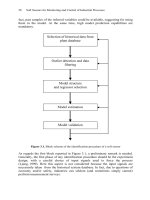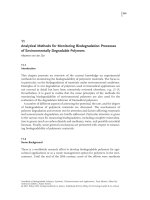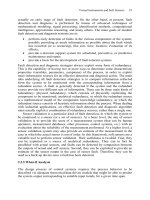Anomaly detection for monitoring
Bạn đang xem bản rút gọn của tài liệu. Xem và tải ngay bản đầy đủ của tài liệu tại đây (5.66 MB, 103 trang )
Anomaly Detection for
Monitoring
A Statistical Approach to Time Series Anomaly Detection
Preetam Jinka & Baron Schwartz
Anomaly Detection for Monitoring
by Preetam Jinka and Baron Schwartz
Copyright © 2015 O’Reilly Media, Inc. All rights reserved.
Printed in the United States of America.
Published by O’Reilly Media, Inc., 1005 Gravenstein Highway North,
Sebastopol, CA 95472.
O’Reilly books may be purchased for educational, business, or sales
promotional use. Online editions are also available for most titles
(). For more information, contact our
corporate/institutional sales department: 800-998-9938 or
.
Editor: Brian Anderson
Production Editor: Nicholas Adams
Proofreader: Nicholas Adams
Interior Designer: David Futato
Cover Designer: Karen Montgomery
Illustrator: Rebecca Demarest
September 2015: First Edition
Revision History for the First Edition
2015-10-06: First Release
2016-03-09: Second Release
The O’Reilly logo is a registered trademark of O’Reilly Media, Inc. Anomaly
Detection for Monitoring, the cover image, and related trade dress are
trademarks of O’Reilly Media, Inc.
While the publisher and the authors have used good faith efforts to ensure
that the information and instructions contained in this work are accurate, the
publisher and the authors disclaim all responsibility for errors or omissions,
including without limitation responsibility for damages resulting from the use
of or reliance on this work. Use of the information and instructions contained
in this work is at your own risk. If any code samples or other technology this
work contains or describes is subject to open source licenses or the
intellectual property rights of others, it is your responsibility to ensure that
your use thereof complies with such licenses and/or rights.
978-1-491-93578-1
[LSI]
Foreword
Monitoring is currently undergoing a significant change. Until two or three
years ago, the main focus of monitoring tools was to provide more and better
data. Interpretation and visualization has too often been an afterthought.
While industries like e-commerce have jumped on the data analytics train
very early, monitoring systems still need to catch up.
These days, systems are getting larger and more dynamic. Running hundreds
of thousands of servers with continuous new code pushes in elastic, selfscaling server environments makes data interpretation more complex than
ever. We as an industry have reached a point where we need software tooling
to augment our human analytical skills to master this challenge.
At Ruxit, we develop next-generation monitoring solutions based on artificial
intelligence and deep data (large amounts of highly interlinked pieces of
information). Building self-learning monitoring systems—while still in its
early days—helps operations teams to focus on core tasks rather than trying
to interpret a wall of charts. Intelligent monitoring is also at the core of the
DevOps movement, as well-interpreted information enables sharing across
organisations.
Whenever I give a talk about this topic, at least one person raises the question
about where he can buy a book to learn more about the topic. This was a
tough question to answer, as most literature is targeted toward
mathematicians—if you want to learn more on topics like anomaly detection,
you are quickly exposed to very advanced content. This book, written by
practitioners in the space, finds the perfect balance. I will definitely add it to
my reading recommendations.
Alois Reitbauer,
Chief Evangelist, Ruxit
Chapter 1. Introduction
Wouldn’t it be amazing to have a system that warned you about new
behaviors and data patterns in time to fix problems before they happened, or
seize opportunities the moment they arise? Wouldn’t it be incredible if this
system was completely foolproof, warning you about every important
change, but never ringing the alarm bell when it shouldn’t? That system is the
holy grail of anomaly detection. It doesn’t exist, and probably never will.
However, we shouldn’t let imperfection make us lose sight of the fact that
useful anomaly detection is possible, and benefits those who apply it
appropriately.
Anomaly detection is a set of techniques and systems to find unusual
behaviors and/or states in systems and their observable signals. We hope that
people who read this book do so because they believe in the promise of
anomaly detection, but are confused by the furious debates in thoughtleadership circles surrounding the topic. We intend this book to help
demystify the topic and clarify some of the fundamental choices that have to
be made in constructing anomaly detection mechanisms. We want readers to
understand why some approaches to anomaly detection work better than
others in some situations, and why a better solution for some challenges may
be within reach after all.
This book is not intended to be a comprehensive source for all information on
the subject. That book would be 1000 pages long and would be incomplete at
that. It is also not intended to be a step-by-step guide to building an anomaly
detection system that will work well for all applications—we’re pretty sure
that a “general solution” to anomaly detection is impossible. We believe the
best approach for a given situation is dependent on many factors, not least of
which is the cost/benefit analysis of building more complex systems. We
hope this book will help you navigate the labyrinth by outlining the tradeoffs
associated with different approaches to anomaly detection, which will help
you make judgments as you reach forks in the road.
We decided to write this book after several years of work applying anomaly
detection to our own problems in monitoring and related use cases. Both of
us work at VividCortex, where we work on a large-scale, specialized form of
database monitoring. At VividCortex, we have flexed our anomaly detection
muscles in a number of ways. We have built, and more importantly
discarded, dozens of anomaly detectors over the last several years. But not
only that, we were working on anomaly detection in monitoring systems even
before VividCortex. We have tried statistical, heuristic, machine learning,
and other techniques.
We have also engaged with our peers in monitoring, DevOps, anomaly
detection, and a variety of other disciplines. We have developed a deep and
abiding respect for many people, projects and products, and companies
including Ruxit among others. We have tried to share our challenges,
successes, and failures through blogs, open-source software, conference talks,
and now this book.
Why Anomaly Detection?
Monitoring, the practice of observing systems and determining if they’re
healthy, is hard and getting harder. There are many reasons for this: we are
managing many more systems (servers and applications or services) and
much more data than ever before, and we are monitoring them in higher
resolution. Companies such as Etsy have convinced the community that it is
not only possible but desirable to monitor practically everything we can, so
we are also monitoring many more signals from these systems than we used
to.
Any of these changes presents a challenge, but collectively they present a
very difficult one indeed. As a result, now we struggle with making sense out
of all of these metrics.
Traditional ways of monitoring all of these metrics can no longer do the job
adequately. There is simply too much data to monitor.
Many of us are used to monitoring visually by actually watching charts on the
computer or on the wall, or using thresholds with systems like Nagios.
Thresholds actually represent one of the main reasons that monitoring is too
hard to do effectively. Thresholds, put simply, don’t work very well. Setting
a threshold on a metric requires a system administrator or DevOps
practitioner to make a decision about the correct value to configure.
The problem is, there is no correct value. A static threshold is just that: static.
It does not change over time, and by default it is applied uniformly to all
servers. But systems are neither similar nor static. Each system is different
from every other, and even individual systems change, both over the long
term, and hour to hour or minute to minute.
The result is that thresholds are too much work to set up and maintain, and
cause too many false alarms and missed alarms. False alarms, because normal
behavior is flagged as a problem, and missed alarms, because the threshold is
set at a level that fails to catch a problem.
You may not realize it, but threshold-based monitoring is actually a crude
form of anomaly detection. When the metric crosses the threshold and
triggers an alert, it’s really flagging the value of the metric as anomalous. The
root of the problem is that this form of anomaly detection cannot adapt to the
system’s unique and changing behavior. It cannot learn what is normal.
Another way you are already using anomaly detection techniques is with
features such as Nagios’s flapping suppression, which disallows alarms when
a check’s result oscillates between states. This is a crude form of a low-pass
filter, a signal-processing technique to discard noise. It works, but not all that
well because its idea of noise is not very sophisticated.
A common assumption is that more sophisticated anomaly detection can
solve all of these problems. We assume that anomaly detection can help us
reduce false alarms and missed alarms. We assume that it can help us find
problems more accurately with less work. We assume that it can suppress
noisy alerts when systems are in unstable states. We assume that it can learn
what is normal for a system, automatically and with zero configuration.
Why do we assume these things? Are they reasonable assumptions? That is
one of the goals of this book: to help you understand your assumptions, some
of which you may not realize you’re making. With explicit assumptions, we
believe you will be prepared to make better decisions. You will be able to
understand the capabilities and limitations of anomaly detection, and to select
the right tool for the task at hand.
The Many Kinds of Anomaly Detection
Anomaly detection is a complicated subject. You might understand this
already, but nevertheless it is probably still more complicated than you
believe. There are many kinds of anomaly detection techniques. Each
technique has a dizzying number of variations. Each of these is suitable, or
unsuitable, for use in a number of scenarios. Each of them has a number of
edge cases that can cause poor results. And many of them are based on
advanced math, statistics, or other disciplines that are beyond the reach of
most of us.
Still, there are lots of success stories for anomaly detection in general. In fact,
as a profession, we are late at applying anomaly detection on a large scale to
monitoring. It certainly has been done, but if you look at other professions,
various types of anomaly detection are standard practice. This applies to
domains such as credit card fraud detection, monitoring for terrorist activity,
finance, weather, gambling, and many more too numerous to mention. In
contrast to this, in systems monitoring we generally do not regard anomaly
detection as a standard practice, but rather as something potentially promising
but leading edge.
The authors of this book agree with this assessment, by and large. We also
see a number of obstacles to be overcome before anomaly detection is
regarded as a standard part of the monitoring toolkit:
It is difficult to get started, because there’s so much to learn before you
can even start to get results.
Even if you do a lot of work and the results seem promising, when you
deploy something into production you can find poor results often enough
that nothing usable comes of your efforts.
General-purpose solutions are either impossible or extremely difficult to
achieve in many domains. This is partially because of the incredible
diversity of machine data. There are also apparently an almost infinite
number of edge cases and potholes that can trip you up. In many of these
cases, things appear to work well even when they really don’t, or they
accidentally work well, leading you to think that it is by design. In other
words, whether something is actually working or not is a very subtle thing
to determine.
There seems to be an unlimited supply of poor and incomplete
information to be found on the Internet and in other sources. Some of it is
probably even in this book.
Anomaly detection is such a trendy topic, and it is currently so cool and
thought-leadery to write or talk about it, that there seem to be incentives
for adding insult to the already injurious amount of poor information just
mentioned.
Many of the methods are based on statistics and probability, both of which
are incredibly unintuitive, and often have surprising outcomes. In the
authors’ experience, few things can lead you astray more quickly than
applying intuition to statistics.
As a result, anomaly detection seems to be a topic that is all about extremes.
Some people try it, or observe other people’s efforts and results, and
conclude that it is impossible or difficult. They give up hope. This is one
extreme. At the other extreme, some people find good results, or believe they
have found good results, at least in some specific scenario. They mistakenly
think they have found a general purpose solution that will work in many more
scenarios, and they evangelize it a little too much. This overenthusiasm can
result in negative press and vilification from other people. Thus, we seem to
veer between holy grails and despondency. Each extreme is actually an
overcorrection that feeds back into the cycle.
Sadly, none of this does much to educate people about the true nature and
benefits of anomaly detection. One outcome is that a lot of people are
missing out on benefits that they could be getting. Another is that they may
not be informed enough to have realistic opinions about commercially
available anomaly detection solutions. As Zen Master Hakuin said,
Not knowing how near the truth is, we seek it far away.
Conclusions
If you are like most of our friends in the DevOps and web operations
communities, you probably picked up this book because you’ve been hearing
a lot about anomaly detection in the last few years, and you’re intrigued by it.
In addition to the previously-mentioned goal of making assumptions explicit,
we hope to be able to achieve a number of outcomes in this book.
We want to help orient you to the subject and the landscape in general.
We want you to have a frame of reference for thinking about anomaly
detection, so you can make your own decisions.
We want to help you understand how to assess not only the meaning of the
answers you get from anomaly detection algorithms, but how trustworthy
the answers might be.
We want to teach you some things that you can actually apply to your own
systems and your own problems. We don’t want this to be just a bunch of
theory. We want you to put it into practice.
We want your time spent reading this book to be useful beyond this book.
We want you to be able to apply what you have learned to topics we don’t
cover in this book.
If you already know anything about anomaly detection, statistics, or any of
the other things we cover in this book, you’re going to see that we omit or
gloss over a lot of important information. That is inevitable. From prior
experience, we have learned that it is better to help people form useful
thought processes and mental models than to tell them what to think.
As a result of this, we hope you will be able to combine the material in this
book with your existing tools and skills to solve problems on your systems.
By and large, we want you to get better at what you already do, and learn a
new trick or two, rather than solving world hunger. If you ask, “what can I do
that’s a little better than Nagios?” you’re on the right track.
Anomaly detection is not a black and white topic. There is a lot of gray area,
a lot of middle ground. Despite the complexity and richness of the subject
matter, it is both fun and productive. And despite the difficulty, there is a lot
of promise for applying it in practice.
Somewhere between static thresholds and magic, there is a happy medium. In
this book, we strive to help you find that balance, while avoiding some of the
sharp edges.
Chapter 2. A Crash Course in
Anomaly Detection
This isn’t a book about the overall breadth and depth of anomaly detection. It
is specifically about applying anomaly detection to solve common problems
that the DevOps community faces when trying to monitor the types of
systems that we manage the most.
One of the implications is that this book is mostly about time series anomaly
detection. It also means that we focus on widely used tools such as Graphite,
JavaScript, R, and Python. There are several reasons for these choices, based
on assumptions we’re making.
We assume that our audience is largely like ourselves: developers, system
administrators, database administrators, and DevOps practitioners using
mostly open source tools.
Neither of us has a doctorate in a field such as statistics or operations
research, and we assume you don’t either.
We assume that you are doing time series monitoring, much like we are.
As a result of these assumptions, this book is quite biased. It is all about
anomaly detection on metrics, and we will not cover anomaly detection on
configuration, comparing machines amongst each other, log analysis,
clustering similar kinds of things together, or many other types of anomaly
detection. We also focus on detecting anomalies as they happen, because that
is usually what we are trying to do with our monitoring systems.
A Real Example of Anomaly Detection
Around the year 2008, Evan Miller published a paper describing real-time
anomaly detection in operation at IMVU.1 This was Baron’s first exposure to
anomaly detection:
At approximately 5 AM Friday, it first detects a problem [in the number of
IMVU users who invited their Hotmail contacts to open an account], which
persists most of the day. In fact, an external service provider had changed
an interface early Friday morning, affecting some but not all of our users.
The following images from that paper show the metric and its deviation from
the usual behavior.
They detected an unusual change in a really erratic signal. Mind. Blown.
Magic!
The anomaly detection method was Holt-Winters forecasting. It is relatively
crude by some standards, but nevertheless can be applied with good results to
carefully selected metrics that follow predictable patterns. Miller went on to
mention other examples where the same technique had helped engineers find
problems and solve them quickly.
How can you achieve similar results on your systems? To answer this, first
we need to consider what anomaly detection is and isn’t, and what it’s good
and bad at doing.
What Is Anomaly Detection?
Anomaly detection is a way to help find signal in noisy metrics. The usual
definition of “anomaly” is an unusual or unexpected event or value. In the
context of anomaly detection on monitoring metrics, we care about
unexpected values of those metrics.
Anomalies can have many causes. It is important to recognize that the
anomaly in the metric that we are observing is not the same as the condition
in the system that produced the metric. By assuming that an anomaly in a
metric indicates a problem in the system, we are making a mental and
practical leap that may or may not be justified. Anomaly detection doesn’t
understand anything about your systems. It just understands your definition
of unusual or abnormal values.
It is also good to note that most anomaly detection methods substitute
“unusual” and “unexpected” with “statistically improbable.” This is common
practice and often implicit, but you should be aware of the difference.
A common confusion is thinking that anomalies are the same as outliers
(values that are very distant from typical values). In fact, outliers are
common, and they should be regarded as normal and expected. Anomalies
are outliers, at least in most cases, but not all outliers are anomalies.
What Is It Good for?
Anomaly detection has a variety of use cases. Even within the scope of this
book, which we previously indicated is rather small, anomaly detection can
do a lot of things:
It can find unusual values of metrics in order to surface undetected
problems. An example is a server that gets suspiciously busy or idle, or a
smaller than expected number of events in an interval of time, as in the
IMVU example.
It can find changes in an important metric or process, so that humans can
investigate and figure out why.
It can reduce the surface area or search space when trying to diagnose a
problem that has been detected. In a world of millions of metrics, being
able to find metrics that are behaving unusually at the moment of a
problem is a valuable way to narrow the search.
It can reduce the need to calibrate or recalibrate thresholds across a variety
of different machines or services.
It can augment human intuition and judgment, a little bit like the Iron
Man’s suit augments his strength.
Anomaly detection cannot do a lot of things people sometimes think it can.
For example:
It cannot provide a root cause analysis or diagnosis, although it can
certainly assist in that.
It cannot provide hard yes or no answers about whether there is an
anomaly, because at best it is limited to the probability of whether there
might be an anomaly or not. (Even humans are often unable to determine
conclusively that a value is anomalous.)
It cannot prove that there is an anomaly in the system, only that there is
something unusual about the metric that you are observing. Remember,
the metric isn’t the system itself.
It cannot detect actual system faults (failures), because a fault is different
from an anomaly. (See the previous point again.)
It cannot replace human judgment and experience.
It cannot understand the meaning of metrics.
And in general, it cannot work generically across all systems, all metrics,
all time ranges, and all frequency scales.
This last item is quite important to understand. There are pathological cases
where every known method of anomaly detection, every statistical technique,
every test, every false positive filter, everything, will break down and fail.
And on large data sets, such as those you get when monitoring lots of metrics
from lots of machines at high resolution in a modern application, you will
find these pathological cases, guaranteed.
In particular, at a high resolution such as one-second metrics resolution, most
machine-generated metrics are extremely noisy, and will cause most anomaly
detection techniques to throw off lots and lots of false positives.
ARE ANOMALIES RARE?
Depending on how you look at it, anomalies are either rare or common. The usual definition of an
anomaly uses probabilities as a proxy for unusualness. A rule of thumb that shows up often is
three standard deviations away from the mean. This is a technique that we will discuss in depth
later, but for now it suffices to say that if we assume the data behaves exactly as expected, 99.73%
of observations will fall within three sigmas. In other words, slightly less than three observations
per thousand will be considered anomalous.
That sounds pretty rare, but given that there are 1,440 minutes per day, you’ll still be flagging
about 4 observations as anomalous every single day, even in one minute granularity. If you use
one second granularity, you can multiply that number by 60. Suddenly these rare events seem
incredibly common. One might even call them noisy, no?
Is this what you want on every metric on every server that you manage? You make up your own
mind how you feel about that. The point is that many people probably assume that anomaly
detection finds rare events, but in reality that assumption doesn’t always hold.
How Can You Use Anomaly Detection?
To apply anomaly detection in practice, you generally have two options, at
least within the scope of things considered in this book. Option one is to
generate alerts, and option two is to record events for later analysis but don’t
alert on them.
Generating alerts from anomalies in metrics is a bit dangerous. Part of this is
because the assumption that anomalies are rare isn’t as true as you may think.
See the sidebar. A naive approach to alerting on anomalies is almost certain
to cause a lot of noise.
Our suggestion is not to alert on most anomalies. This follows directly from
the fact that anomalies do not imply that a system is in a bad state. In other
words, there is a big difference between an anomalous observation in a
metric, and an actual system fault. If you can guarantee that an anomaly
reliably detects a serious problem in your system, that’s great. Go ahead and
alert on it. But otherwise, we suggest that you don’t alert on things that may
have no impact or consequence.
Instead, we suggest that you record these anomalous observations, but don’t
alert on them. Now you have essentially created an index into the most
unusual data points in your metrics, for later use in case it is interesting. For
example, during diagnosis of a problem that you have detected.
One of the assumptions embedded in this recommendation is that anomaly
detection is cheap enough to do online in one pass as data arrives into your
monitoring system, but that ad hoc, after-the-fact anomaly detection is too
costly to do interactively. With the monitoring data sizes that we are seeing in
the industry today, and the attitude that you should “measure everything that
moves,” this is generally the case. Multi-terabyte anomaly detection analysis
is usually unacceptably slow and requires more resources than you have
available. Again, we are placing this in the context of what most of us are
doing for monitoring, using typical open-source tools and methodologies.
Conclusions
Although it’s easy to get excited about success stories in anomaly detection,
most of the time someone else’s techniques will not translate directly to your
systems and your data. That’s why you have to learn for yourself what works,
what’s appropriate to use in some situations and not in others, and the like.
Our suggestion, which will frame the discussion in the rest of this book, is
that, generally speaking, you probably should use anomaly detection “online”
as your data arrives. Store the results, but don’t alert on them in most cases.
And keep in mind that the map is not the territory: the metric isn’t the system,
an anomaly isn’t a crisis, three sigmas isn’t unlikely, and so on.
1
“Aberrant Behavior Detection in Time Series for Monitoring Business-Critical Metrics”
Chapter 3. Modeling and
Predicting
Anomaly detection is based on predictions derived from models. In simple
terms, a model is a way to express your previous knowledge about a system
and how you expect it to work. A model can be as simple as a single
mathematical equation.
Models are convenient because they give us a way to describe a potentially
complicated process or system. In some cases, models directly describe
processes that govern a system’s behavior. For example, VividCortex’s
Adaptive Fault Detection algorithm uses Little’s law1 because we know that
the systems we monitor obey this law. On the other hand, you may have a
process whose mechanisms and governing principles aren’t evident, and as a
result doesn’t have a clearly defined model. In these cases you can try to fit a
model to the observed system behavior as best you can.
Why is modeling so important? With anomaly detection, you’re interested in
finding what is unusual, but first you have to know what to expect. This
means you have to make a prediction. Even if it’s implicit and unstated, this
prediction process requires a model. Then you can compare the observed
behavior to the model’s prediction.
Almost all online time series anomaly detection works by comparing the
current value to a prediction based on previous values. Online means you’re
doing anomaly detection as you see each new value appear, and online
anomaly detection is a major focus of this book because it’s the only way to
find system problems as they happen. Online methods are not instantaneous
—there may be some delay—but they are the alternative to gathering a chunk
of data and performing analysis after the fact, which often finds problems too
late.
Online anomaly detection methods need two things: past data and a model.
Together, they are the essential components for generating predictions.









